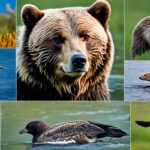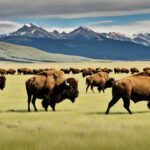Ever wondered if there are still wild ferrets in the USA? The focus is on the black-footed ferret, America’s native ferret. These ferrets used to roam the Great Plains and areas between mountains. But, their numbers dropped a lot, which called for big efforts to save them.
The black-footed ferret is now a protected species. It lives on thanks to careful plans to bring it back. The last time it was seen wild was in 1987, which is very important in its story.
Captive breeding has helped build up new populations in certain places in the USA. This story looks at the detailed path of the black-footed ferret. It also shows its place among the other wild ferrets in North America.
Introduction to Ferret Species in the USA
The black-footed ferret, Mustela nigripes, is highly regarded by USA enthusiasts. They are medium-sized carnivores native to the U.S., unlike domesticated ferrets. These ferrets are adapted to the wild, surviving in North America’s ecosystems.
In the past, black-footed ferrets lived in many U.S. states, but their numbers have fallen. This decline was due to losing their habitat, diseases, and losing their main food, prairie dogs. Conservation efforts aim to increase their numbers.
Black-footed ferrets play a vital role in the prairies’ well-being. Reintroducing them supports the balance and variety of these ecosystems.
History of the Black-Footed Ferret
The black-footed ferret is a vital part of the USA ferret population. It dates back to 1851, when it was first noted. These wild ferrets of North America have been around for about 100,000 years, seen in fossils. There were once 500,000 to 1 million of them. However, their numbers fell sharply after that time.
Discovery and Early Records
The black-footed ferret was found all over the Great Plains at first. They were key to the local ecosystem. But, as agriculture grew and new diseases appeared, they started to decrease in number.
Decline and Rediscovery
In the 1950s, the USA ferret population neared extinction. This was because of losing their homes and other human-made issues. But, their luck changed in 1964 when a few were found in South Dakota. Then, in 1981, more were found in Wyoming. This led to efforts to save them through breeding programs.
Are there any wild ferrets in the USA?
When you ask, Are there any wild ferrets in the USA?, remember this. The black-footed ferret is the only kind that can be wild in the country. However, humans have helped a lot for them to be back in the wild. They were almost gone but reintroduction projects brought them back.
But, pet ferrets cannot live in the wild. They don’t have the skills to survive there. So, if you’re thinking about wild ferrets in the USA, know they really need our help. Conservation work is crucial for them to keep living in their natural homes.
| Types of Ferrets in the USA | Characteristics |
|---|---|
| Black-Footed Ferret | Considered wild but part of recovery programs |
| Domesticated Ferret | Not wild, would fare poorly if released |
Characteristics of Black-Footed Ferrets
The American wild ferrets, especially the black-footed ones, have special traits. These make them stand out as amazing creatures of the wild known as wild ferrets USA.
Physical Traits
Black-footed ferrets are known for their unique black markings. You can see these markings on their feet, ears, and face. They are part of the mustelid family, just like weasels, badgers, and otters. Their features, such as a slim body and sharp senses, help them survive in North America’s grasslands. This unique blend of characteristics lets them move through their homes well. It helps them stay away from danger and catch their food.
Behavior and Diet
Black-footed ferrets eat meat and mainly hunt prairie dogs. They only hunt at night, making them nocturnal. This lifestyle helps them stay safe and matches when their food is active. Black-footed ferrets need prairie dog homes for both food and shelter. This shows how their diet and hunting at night are tied to their environment and survival. Wild ferrets USA depend on a delicate ecosystem.
Conservation Efforts and Success Stories
Efforts to save wild ferrets in North America are making a big difference. The National Black-Footed Ferret Conservation Center is a key player. It works with sites in the USA and Canada to help ferret populations grow. They aim to bring these animals back to their natural homes.
In places like Shirley Basin, Wyoming, ferret numbers are rising again. This success is crucial for the ferrets’ future. Thanks to the hard work of many, ferret programs are working well. As a result, there’s hope that wild ferrets in North America will soon thrive.
- Establishment of breeding facilities in the USA and Canada
- Success stories in Shirley Basin, Wyoming
- Collaborative efforts leading to measurable success
These stories show how important it is to keep working on wild ferret conservation. With continued efforts, we can see strong, growing ferret populations in North America.
Habitat Requirements of Black-Footed Ferrets
The habitat black-footed ferrets thrive in semi-arid grasslands, prairies, and mountain basins. In these places, they find the perfect living conditions, much like their original habitats. They especially like areas where prairie dogs live. This is because these environments offer food and burrow networks, which are vital for the ferrets to live and reproduce.
Preferred Habitats
Black-footed ferrets call North America home. They love being in wide, open spaces with prairie dogs. This is because they find plenty of food and safe places to make their homes. The link between these ferrets and their homes shows why it’s so important to protect these areas. This effort helps keep our wild ferret population strong.
Interaction with Prairie Dogs
One key thing in the habitat black-footed ferrets rely on is their interaction with prairie dogs. Prairie dogs are more than snacks for these ferrets; they are also a valuable source of shelter and hunting spots. This unique relationship shows us how having lots of prairie dogs around is vital. It means the ferrets can keep on thriving in the wild.
Current Threats to Wild Ferret Populations
Efforts to save the wild ferrets in the USA have been huge. But, they still face big issues. Disease is a major worry for their future, with sylvatic plague and canine distemper being top dangers. Though we can vaccinate against canine distemper, controlling sylvatic plague is hard. This remains a big fight for those trying to save the ferrets.
Disease
Black-footed ferrets are in danger from contagious illnesses in their natural home. Sylvatic plague, from *Yersinia pestis*, and canine distemper are especially deadly. We’ve made progress against canine distemper through vaccines. However, sylvatic plague still poses a big problem. Scientists are working hard to find better ways to deal with the disease and protect the ferrets.
Habitat Destruction
The places where black-footed ferrets live are being destroyed. This is a result of buildings going up, more farms, and the killing of prairie dogs. Without their needed living spaces, the ferrets suffer. It’s vital to save and rebuild the places ferrets call home.
Genetic Diversity
The number of black-footed ferrets still around is small. This means keeping their genetic variety alive is tough. Inbreeding from not enough genetic variety causes health and fitness problems. This puts the species at risk in the long run. So, efforts focus on watching and managing the ferrets’ genetic makeup to keep them strong and healthy.
Black-Footed Ferret Breeding Programs
The Smithsonian Conservation Biology Institute and Cheyenne Mountain Zoo are big players in saving black-footed ferrets. They use advanced methods like artificial insemination to keep the ferrets genetically strong and alive.
These places aim to help the wild ferret population grow. They carefully manage how black-footed ferrets are bred, making sure each new ferret is healthy and diverse.
They keep detailed records and analyze the genetics closely. This helps the different zoos and centers work together smoothly. With teamwork, they make sure their work saves the ferrets.
Here’s how some top breeding programs help the black-footed ferrets bounce back:
| Facility | Primary Objective | Methods Used |
|---|---|---|
| Smithsonian Conservation Biology Institute | Increase population | Artificial insemination, genetic analysis |
| Cheyenne Mountain Zoo | Enhance genetic diversity | Natural breeding, health monitoring |
This hard work in breeding is key to the black-footed ferrets’ future. It shows a strong dedication to saving them. The efforts give us hope that these ferrets will thrive again in the wild.
Reintroduction of Black-Footed Ferrets
The black-footed ferrets are getting a second chance at life thanks to projects in the USA, Canada, and Mexico. These efforts aim to let the ferrets live freely in their old homes again.

Reintroduction Sites
The places chosen for the ferrets are picked carefully. They need to be able to find enough food and find a safe place to live. This ensures the ferrets have a good chance of doing well once they’re back in the wild.
Efforts are focused on states like Wyoming, South Dakota, and Montana. Canada and Mexico are also working on similar projects. Black-footed ferrets are being brought back over a large area.
Preconditioning for Wild Release
Before the ferrets are set free, they learn how to live by themselves. This includes getting used to living in burrows and learning survival skills. All this prepares them to survive in the wild.
After their release, humans step back to let the ferrets thrive on their own. This approach has been crucial in their successful re-entry into the wild. Visitors can witness the positive outcomes of these intensive efforts first-hand.
Comparison with Other Ferret Species
When we look at ferret species USA, it’s key to understand the black-footed ferret’s uniqueness among American wild ferrets. It has special traits that help it live in North America’s ecosystems. This makes it different from the European polecat and the Steppe polecat.
By comparing them, we can see the challenges these wild ferrets face and their ecological roles. The black-footed ferret needs prairie dog colonies for its food and home. So, its survival links closely with these prairie dog groups’ wellbeing.
| Species | Geographical Range | Primary Prey | Status |
|---|---|---|---|
| Black-Footed Ferret (Mustela nigripes) | North America (USA) | Prairie Dogs | Endangered |
| European Polecat (Mustela putorius) | Europe | Small Mammals and Birds | Least Concern |
| Steppe Polecat (Mustela eversmanii) | Eastern Europe to Central Asia | Rodents | Least Concern |
Understanding these differences shows why the black-footed ferret needs special conservation efforts. It plays a crucial role in North America’s prairie ecosystem. Knowing this can lead to more support for the efforts to save these American wild ferrets.
Future Prospects for Wild Ferrets in the USA
The future of wild ferrets in the USA relies on dedicated efforts for conservation, habitat restoration, and in-depth research. These efforts aim to ensure that the black-footed ferret populations are stable in their original habitats. Conservation work is crucial to prevent these animals from becoming extinct again.
Bison ranching is a new approach that aids in the preservation of prairies. This method not only helps to keep the variety of life, but also creates a better home for black-footed ferrets. The connection between healthy prairies and the ferrets’ survival shows the need for a complete conservation approach.
Science is also playing a huge role in the future of ferrets in the USA. Research on disease resistance and improving genetic diversity is making way for strong, independent populations. With these developments, the future looks brighter for black-footed ferrets, showing a growing desire to protect America’s wild places.
FAQ
Are there any wild ferrets in the USA?
Yes, the USA has the black-footed ferret, which is native. It lives in North America mainly because of conservation efforts. They were almost gone due to being endangered. But, they were brought back through hard work.
What ferret species exist in the USA?
The black-footed ferret is the only kind that lives here without human help. Then, there are the domestic ferrets. People keep these as pets, but they can’t survive in the wild.
How were black-footed ferrets discovered and what is their history?
Scientists first found black-footed ferrets in 1851. There used to be many of them before human activities made their lives hard. Disease and land changes hurt them a lot.
What caused the decline of the black-footed ferret population, and how were they rediscovered?
They started vanishing because they lost their homes and got sick. By the 1950s, they were almost gone. Luckily, people found some in the wild again. These discoveries led to efforts to bring them back.
How are black-footed ferrets distinct from domesticated ferrets?
Wild black-footed ferrets are very different from pet ferrets. They live naturally in dry lands and need prairie dogs to survive. This makes them unique compared to those you see as pets.
What are the physical traits and behaviors of black-footed ferrets?
They look medium-sized and have black parts on them. They mainly hunt at night, feeding on prairie dogs. This is how they live their daily lives.
What conservation efforts have been successful for black-footed ferrets?
Building places like the National Black-Footed Ferret Conservation Center has helped a lot. They also used areas where ferrets once lived. Now, in Wyoming, there are more ferrets thanks to these efforts.
What are the habitat requirements for black-footed ferrets?
They like dry lands and need prairie dogs around. These places provide food and home tunnels for the ferrets.
What are the primary threats to wild black-footed ferret populations?
Wild ferrets face dangers like diseases and losing their homes to farms or cities. Another big problem is they don’t have many family members. This makes their community weaker.
What role do breeding programs play in black-footed ferret conservation?
The programs at places like the Smithsonian and Cheyenne Mountain Zoo do a lot. They breed ferrets carefully, using new methods. This helps keep the ferrets different from each other, which is very important.
Where are black-footed ferrets being reintroduced, and what is preconditioning?
They’re being put back in many places across the Western USA and even in Canada and Mexico. Before they go, they are taught how to live in the wild. This way, they can better survive after they leave humans.
How do black-footed ferrets compare with other ferret species?
They are a special kind of ferret in North America. The many types of ferrets are like family in nature. Knowing this helps us save the ones that really need help.
What does the future hold for wild ferrets in the USA?
There is hope for the ferrets with more work in saving them. This means fixing their homes, stopping diseases, and caring for their families. Efforts to make the land healthy for them also give hope.







